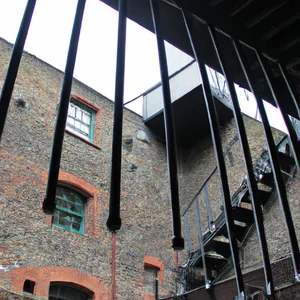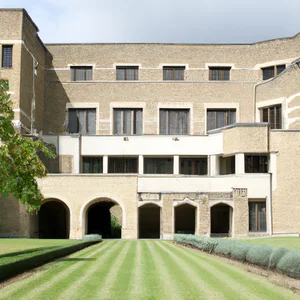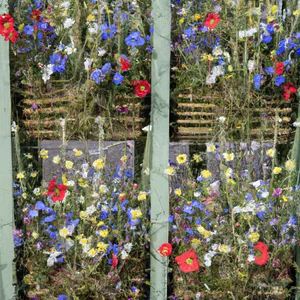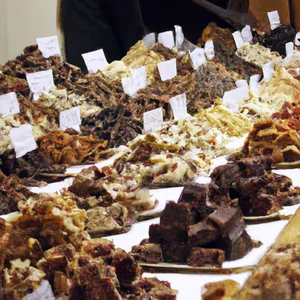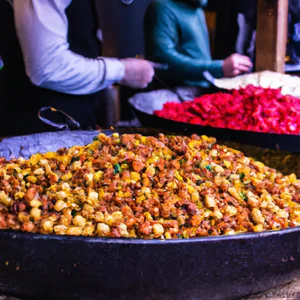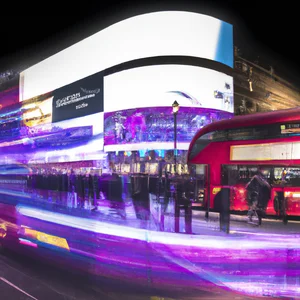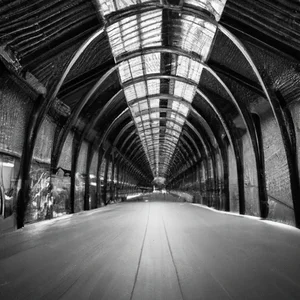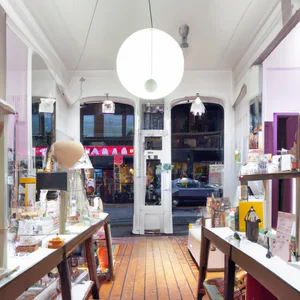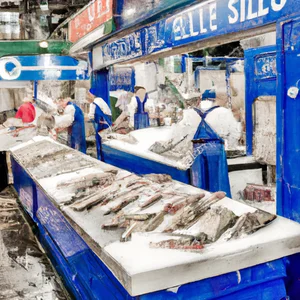Book your experience
London Cycling: the best cycle routes to explore the capital on two wheels
Parkland Walk is one of those discoveries that makes you feel a bit like an explorer in your own neighborhood. Imagine an old railway line that, instead of being forgotten over time, has transformed into a green corner where the birds sing and nature has taken over. It’s as if the city took a break and decided to give nature a hug.
When I first went there, I didn’t know what to expect. I was a little skeptical, I have to admit, but as soon as I set foot on that path, I knew I had hit the jackpot. Plants grew everywhere, almost as if they were celebrating their newfound freedom. There was a sort of magic in the air, an almost fairytale atmosphere. I don’t know if it was the scent of the damp earth or the birds singing, but I immediately felt transported away from everyday stress.
It’s incredible to think that trains once passed here, full of people coming and going. Now, however, it is a refuge for those who want to unplug a bit. I saw families, cyclists, and even some artists who started painting, as if that place were a blank canvas. It’s kind of like nature is repainting the world its way, and we’re, well, just passing through.
And then, speaking of experiences, I remember that I once met an elderly gentleman who told me about when he took the train to go to work. He told me that life was different, but that he now loves walking here because it’s like going back to the origins, but with a touch of freshness. It’s nice to see how certain places manage to unite different generations, don’t you think?
In short, Parkland Walk is a little corner of paradise amidst the chaos of urban life. If you’ve never been, I highly recommend it. It may not be an epic journey, but it certainly gives you moments of tranquility and beauty that, at the end of the day, make the difference. And who knows, maybe one day you too will find it as fascinating as I found it!
Discover the history of the Parkland Walk
Walking along the Parkland Walk, I can’t help but feel the echoes of past stories intertwined with the vibrant energy of the present. I remember the first time I set foot on this former railway line, the scent of nature mixing with memories of trains that once rushed between stations. It was as if each step had the power to rekindle the past, revealing the forgotten history of an infrastructure that had served the London community for over a century.
A journey through time
Built in the 1800s, Parkland Walk was part of the North London Railway, a major transport artery linking various boroughs. With the definitive closure of the line in 1970, the area saw a surprising transformation: from abandoned tracks to a nature reserve. Today, this 4.5-mile trail is a nature and history lover’s paradise, where wild vegetation has taken over rusted tracks and railroad signals.
An insider tip
A little-known tip for those visiting the Parkland Walk is to look for the remains of ancient trains that lie hidden among the vegetation. In particular, in some less traveled points, you can find the remains of wagons and railway equipment, offering a fascinating contrast between the lush greenery and the industrial history. These places are not only photographically interesting, but also offer a unique opportunity for reflection on how progress and nature can coexist.
The cultural and historical impact
The transformation of the Parkland Walk from railway to nature reserve has had a significant impact on the local community. It has in fact encouraged greater environmental awareness and inspired redevelopment projects in other urban areas. It has become a symbol of how abandoned spaces can be rethought and reused, promoting sustainable and responsible tourism. The Parkland Walk is not just a route; it is an example of urban resilience.
An experience not to be missed
If you want to completely immerse yourself in the history of this place, I recommend taking part in one of the guided tours organized by local groups such as “Parkland Walk Rangers”. These walks not only offer a great opportunity to learn about the history of the railway, but often also include anecdotes and personal stories from those who have experienced the transformation of this area.
Final reflection
As you walk along the Parkland Walk, I invite you to reflect on how the places we pass through are much more than just paths. Every corner tells a story, and every step brings us closer to a deeper connection with our environment and our history. Have you ever wondered what story your daily journey could tell?
A path between nature and urbanization
A personal experience
I still remember the first time I walked along the Parkland Walk, a path that seems like an invisible line between the frenzy of London’s urban life and the serenity of nature. As I walked, the sound of trains in the distance mixed with the chirping of birds, creating a harmony that is rare to find in a metropolis. This route is not just a way to move from one point to another; it is a journey that invites us to reflect on the coexistence of urbanization and nature.
Practical information
The Parkland Walk runs approximately 4.5 miles (7.2 km) from Finsbury Park to Highgate, following an old disused railway that has been transformed into a green corridor. It is accessible all year round and easily reached via the tube, with nearby stations such as Finsbury Park and Highgate. You can find further details at Visit London to plan your visit.
Unconventional advice
A little-known tip is to visit the Parkland Walk early in the morning, when the golden sunlight filters through the trees and the animals are most active. It’s a magical time that offers unique photo opportunities, away from the crowds.
Cultural and historical impact
This route is not just a natural wonder; it also represents an important chapter in London’s history. The railroad that created the Parkland Walk opened in 1867 and served as a transportation route for decades. Its transformation into a public park is an example of how the city can adapt and reuse spaces creatively, preserving greenery in an ever-expanding urban context.
Sustainability on the move
Walking along the Parkland Walk is also an act of sustainable tourism. By choosing to explore on foot, you reduce your environmental impact and contribute to a greater awareness of the importance of preserving green spaces. Additionally, the route is part of a trail network that encourages active and responsible transportation.
A vivid atmosphere
Imagine finding yourself surrounded by centuries-old trees, with the scent of damp earth and the sound of water flowing in small streams. The glimpses of Victorian architecture that overlook the path tell stories of a rich past, while the rustling leaves under your feet remind you that, even in a big city, nature always finds a way to assert itself.
Activities to try
During your walk, don’t forget to stop at “Highgate Wood”, an enchanting woodland where you can organize a picnic or simply enjoy the tranquility. If you are a birdwatcher, bring binoculars with you and try to spot local species such as the green woodpecker and the chaffinch.
Myths to dispel
A common misconception is that the Parkland Walk is just a through trail, but in in reality, it is an immersive experience that offers much more. It’s not just a path; it’s a refuge for wildlife and a place to connect with nature, even in the heart of one of the busiest cities in the world.
A final reflection
Walking along the Parkland Walk is an invitation to reflect on how we can balance modern life with the beauty of nature. What is your favorite experience when you are in an urban environment? Have they ever made you feel so close to nature, even in the middle of the city?
Outdoor activities: trekking and bird watching
Discover the Park through its paths
I vividly remember my first walk along the Parkland Walk, a route that winds for about 4.5 kilometers through the neighborhoods of North London. As I walked, the scent of the damp earth and the echo of the birds’ songs enveloped me, transporting me into an almost magical atmosphere. A few steps away from the urban frenzy, I discovered a corner of tranquility where the singing of the blackbirds and the rustling of the leaves create a natural melody that eases the mind and refreshes the spirit.
A paradise for nature lovers
The Parkland Walk isn’t just a trail; it is a real oasis for trekking and birdwatching. According to the London Wildlife Trust, this area is a habitat for over 150 species of birds, making it an ideal location for ornithology enthusiasts. Don’t forget to bring binoculars and a bird identification guide with you: you will have the chance to spot woodpeckers, sparrows and, if you’re lucky, even a peregrine falcon in flight.
An insider tip
If you want a truly unique experience, I recommend visiting the Parkland Walk at sunrise. Not only will you have the chance to see the most active birds, but you will also be greeted by the golden morning light, which transforms the landscape into a living painting. Additionally, many of the trails are uncrowded at these times, allowing you to enjoy the beauty of the place in solitude.
A cultural heritage to explore
The Parkland Walk is much more than just a nature trail; it is a testament to London’s industrial history. This space was once part of an abandoned railroad, providing vital connections between neighborhoods. Today, the remains of old stations and stretches of abandoned tracks tell stories of a bygone era, making each step a reflection on the city’s transformation.
Sustainability in focus
Trekking and birdwatching on the Parkland Walk is also a way to practice sustainable tourism. Keeping the trails clean and respecting wildlife is essential. Remember to bring a waste bag with you and leave each place better than you found it: it’s a small gesture that helps preserve the beauty of this ecosystem.
An experience not to be missed
For a memorable experience, try joining one of the birding tours organized by local groups. These events offer not only the opportunity to observe different species, but also to learn more about the flora and fauna of the area from experts in the field.
Myths and misconceptions to dispel
A common misconception is that the Parkland Walk is just a passing point for cyclists and pedestrians. In reality, it is a place rich in biodiversity and culture that deserves to be explored calmly. Don’t underestimate the beauty of small details: an ancient tree, a colorful mural or a group of wild flowers can tell incredible stories.
A final reflection
As I walked along this path, I realized how important it is to take breaks from your busy life. The Parkland Walk is an invitation to slow down, breathe and connect with nature. What is your favorite corner of nature that makes you feel at home?
Hidden treasures: art and murals along the way
A Personal Experience
Walking along the Parkland Walk, a path that winds through the greenery and history of London, I found myself in front of a mural that perfectly captured the essence of the community: a vibrant work that celebrated the cultural diversity of the neighborhood. This isn’t just a trail, it’s an outdoor art gallery where every corner tells a story. I spent an hour contemplating the colors and details, feeling the connection between the artist and the place, while passersby stopped to take photos, sharing a moment of collective beauty.
Art and Murals: A Heritage to Discover
The Parkland Walk is adorned with murals that not only beautify the landscape, but also offer an insight into local culture. From works that reflect social struggles to pieces that celebrate everyday life, the art along the way is the result of local talents and community initiatives. Sources such as Hackney Council and London Mural Festival provide up-to-date information on events and artists contributing to this visual heritage.
Insider advice
If you want to discover the most fascinating murals, I recommend bringing along a map of local street art, available at cafes and visitor centers along the route. Some lesser-known murals are found in side alleys and are often overlooked by tourists. Venture into these back streets and you may discover unique pieces that tell forgotten stories.
Cultural and Historical Impact
The art along the Parkland Walk isn’t just decorative; it is a powerful means of expression. These murals have become symbols of resistance and identity for local communities, contributing to a sense of belonging in an ever-evolving area. The presence of artists and cultural initiatives has also spurred urban renewal, attracting visitors and boosting the local economy.
Sustainability and Responsibility
In a time when sustainable tourism is more important than ever, the Parkland Walk offers an example of how art can contribute to responsible tourism. Local artists use eco-friendly materials and promote sustainability messages through their works. Taking artist-led walking tours is one way to support the local economy and learn more about the history and art of the area.
An Activity to Try
I recommend you take part in an urban art workshop organized by local collectives. These experiences will not only allow you to express your creativity, but will also give you the chance to meet local artists and discover the secrets of street art.
Myths and Misconceptions
A common misconception is that street art is just vandalism. In reality, it is a legitimate form of artistic expression that has deep roots in urban culture. Many murals on the Parkland Walk are commissioned and celebrate the history and culture of the community, rather than destroy it.
Final reflection
As you explore the murals along the Parkland Walk, we invite you to reflect on how art can transform urban spaces and unite communities. What story will the next work of art you encounter along your path tell you?
A journey through time: the abandoned railway
A personal experience
I still remember the moment I stepped onto the Parkland Walk for the first time. The sky was grey, but a ray of sunlight broke through the clouds, illuminating the remains of what was once a dynamic railway. As I walked along the trail, the rusted rails and wooden electrical poles told stories of journeys past. This is not just a walking route; it is a journey through time, a place where history and nature intertwine in an extraordinary way.
Practical information
The Parkland Walk extends approximately 4.5 kilometers from Finsbury Park to Alexandra Palace. Originally, it was part of London’s rail network, but was closed in 1970. Today, this route is a haven for nature and history lovers. The best times to visit are early in the morning or late afternoon, when the light is softer and shadows dance among the trees. For updated information, you can consult the official website of the London Wildlife Trust, which manages part of this area.
An insider tip
A secret that few people know is that along the Parkland Walk there are hidden viewpoints where you can get spectacular views of London. A little-known place is Highgate Bridge, from which you can see the outlines of some of the city’s iconic monuments. Bring binoculars - it’s the perfect place to watch trains pass by on the nearby railway line.
Cultural and historical impact
The abandoned railway has had a significant impact on the local community. Not only did it facilitate transportation, but it also contributed to the growth of neighborhoods such as Finsbury Park and Crouch End. Today, the Parkland Walk is a symbol of urban redevelopment, demonstrating how forgotten spaces can be transformed into places of gathering and recreation for residents and tourists.
Sustainable tourism practices
Walking along the Parkland Walk is an example of responsible tourism, as it encourages sustainable mobility and nature conservation. Choosing to explore this route on foot or by bicycle reduces the environmental impact and allows you to fully appreciate the biodiversity of this ecosystem.
Atmosphere and vivid descriptions
Imagine walking surrounded by centuries-old trees, with birdsong accompanying your every step. The colorful murals that adorn the brick walls tell local stories, the air is fresh and scented with moss and wet leaves. The atmosphere is a mix of tranquility and history, a perfect refuge from the frenzy of urban life.
An experience worth trying
I recommend bringing a camera with you and spending some time exploring the side trails that branch off the Parkland Walk. You may come across hidden corners or small outdoor art galleries, perfect for a creative break.
Myths and misconceptions
A common misconception is that the Parkland Walk is just a simple walking path. In reality, it is a treasure of history and culture, with surprising biodiversity. Don’t be fooled by its appearance; every corner has a story to tell.
Final reflection
As you walk along the Parkland Walk, ask yourself: How many stories of life and change lie beneath your feet? This place is more than just a walk; it is an invitation to reflect on how the past and the present are inextricably linked.
Exclusive Tip: Best times to visit
An unforgettable moment along the Parkland Walk
I still remember my first encounter with the Parkland Walk, when dawn timidly peeked through the leaves of the trees. It was a Saturday morning, and as I walked along the path, the sun began to warm the cool air, creating a magical atmosphere. Birdsong filled the silence, and a few other visitors made their way along the route. This is the perfect time to visit: the early hours of the morning, when nature awakens and the light plays among the branches.
Practical information for an optimal experience
To make the most of your visit to the Parkland Walk, I recommend arriving between 7am and 9am. During these hours, you will not only avoid the crowds, but you will also be able to enjoy the fresh air and observe wildlife without rushing. According to the official Parkland Walk website, this is the time when birds are most active, making the birding experience truly unique. Plus, local cafes open their doors early, allowing you to enjoy a cup of coffee while you get ready to explore.
An insider tip
Here’s a little-known tip: bring a small notebook or camera with you to note down the various types of flora and fauna you encounter. Not only will it be a way to make your walk memorable, but you may also discover plants and animals you didn’t know about. The Parkland Walk is a great place to learn and observe, and taking a moment to reflect on what you see can greatly enrich your experience.
The cultural impact of the Parkland Walk
The Parkland Walk is not just a nature trail; it’s a piece of living history. Once part of London’s rail network, this abandoned route tells stories of an ever-changing city. Its transformation into a public park has had a significant impact on the local community, contributing to a sense of belonging and an opportunity to reconnect with nature. The Parkland Walk is an example of how the past and present can coexist and enrich our environment.
Sustainability and responsibility
When visiting the Parkland Walk, remember to respect the nature around you. Adopting sustainable tourism practices, such as bringing a reusable bottle with you and leaving no waste, is essential to preserving this beauty. The local community has invested time and resources to keep the trail in tip-top condition, and every little gesture counts.
An experience not to be missed
If you’re up for a different activity, consider joining a local hiking group that runs guided walks on the Parkland Walk. This will not only allow you to learn more about the flora and fauna of the place, but also to discover anecdotes and stories that you may not find in tourist guides.
Myths and misconceptions
A common misconception about this trail is that it is only an area for runners and cyclists. In reality, the Parkland Walk offers a much richer and more varied experience, suitable for families, photographers and nature lovers. It’s a place where you can immerse yourself in the tranquility and charm of outdoor living, away from the urban bustle.
A final reflection
Every time I walk along the Parkland Walk, I ask myself: how many stories are hidden among these trees and bushes? The beauty of this path is that it invites us to reflect, to connect with nature and to discover parts of ourselves that we often forget in the frenzy of daily life. We invite you to live this experience and discover the stories that are just waiting to be told.
Sustainability on the move: responsible tourism
A personal experience
I vividly remember my first encounter with the Parkland Walk: a crisp spring morning, with the scent of wildflowers in the air and birdsong accompanying my steps. As I walked along this enchanting route, I realized how important it was to preserve this corner of nature in the heart of London. The Parkland Walk is not just a path through vegetation; it is a living example of how tourism can marry with sustainability.
Practical information
The Parkland Walk stretches for over 4 miles, connecting Highgate to Finsbury Park, and is a haven for those seeking a break from the urban rush. When following this path, it is essential to adopt responsible tourism practices, such as not leaving waste and respecting the surrounding environment. For up-to-date information on sustainability events and initiatives, it is useful to consult the Parkland Walk Association website, which offers resources and tips on how to visit the route in an informed way.
An insider tip
A secret that only locals know is “Parkland Walk Clean Up Day,” an annual event where the community comes together to clean up the trail. Participating in this initiative will not only allow you to actively contribute to conservation of the area, but it will also be an excellent opportunity to socialize with other nature and sustainability enthusiasts. Check social media for dates and information on how to join.
Cultural impact
The Parkland Walk is not just a nature trail, but a symbol of how the city can evolve in harmony with the environment. This path, once a railway line, has been redeveloped to offer citizens a place to reconnect with nature. The initiative has had a significant impact, inspiring other cities to consider similar paths to promote environmental well-being.
Sustainable tourism practices
Adopting a sustainable lifestyle while visiting the Parkland Walk is simple and rewarding. Use environmentally friendly means of transport such as bicycles or public transport to reach the starting point. During the walk, opt for local and organic snacks, bringing reusable containers with you to avoid single-use plastic. This not only reduces environmental impact, but also supports local businesses.
An activity worth trying
If you want a unique experience, I recommend taking a guided birdwatching tour along the Parkland Walk. These events, led by expert naturalists, offer the chance to observe the area’s rich birdlife and learn more about local species and their habitat.
Common myths
A common misconception is that the Parkland Walk is just a tourist walk. In reality, it is a place loved by residents, a refuge where many Londoners go to escape the chaos of the city. It is not just a tourist attraction, but an integral part of the daily life of those who live here.
Final reflection
As you walk along the trail, take a moment to reflect on how your actions affect the environment. What impact can the way you travel have on the natural beauty around you? The Parkland Walk is an invitation to explore, but also to protect. Are you ready to discover this sustainable wonder?
Local encounters: cafes and markets along the way
Imagine stopping along the Parkland Walk path, the scent of fresh coffee wafting through the air as you approach a charming local café. The first time I visited this corner of London, I was greeted by a smiling bartender who told me the story of his small business, a haven for locals and visitors looking to refresh themselves. This is just a taste of the wonders that can be discovered along the way, where local cafes and markets are not just places to eat, but are also centers of community life and culture.
Cafés and markets: a taste of local life
Along Parkland Walk, you’ll find a number of cafes and markets offering fresh, artisanal produce. Markets, such as the Crouch End Farmers’ Market, are held every Sunday and offer a selection of organic fruit and vegetables, artisanal cheeses and local sweets. It’s a perfect opportunity to interact with producers and discover the variety of flavors the area has to offer.
- Local cafes: Are you looking for a place to relax? Try Café Nero or The Haberdashery, where you can enjoy a full English breakfast accompanied by excellent coffee, surrounded by a welcoming and artistic atmosphere.
- Markets: Don’t miss Hornsey Market, where you’ll find local artisan stalls displaying artwork, jewelery and fresh food.
A little-known tip
For a more authentic experience, visit Crouch End market on weekdays. Many of the producers offer free samples of their products, allowing you to taste the local freshness before you buy. It’s an opportunity to chat with vendors and discover fascinating stories about their business.
The cultural and historical impact
This area is not just a place to purchase goods; it also represents an important part of the local community. The cafes and markets along Parkland Walk have been instrumental in preserving the neighborhood’s culture and identity, serving as a meeting point for residents and visitors. Their presence has helped keep alive the spirit of solidarity and community that characterizes this area of London.
Sustainable tourism practices
Many of the cafes and markets along the route are actively committed to sustainability, using local ingredients and eco-friendly practices. By choosing to eat here, you not only support the local economy, but you will also contribute to reducing the environmental impact linked to the transport of goods.
An activity worth trying
For the full experience, take time to picnic with produce purchased at the market and enjoy the natural beauty of Parkland Walk. Find a quiet corner, spread a blanket and let yourself be enveloped by the tranquility of the place while savoring the local gastronomic delights.
Exposing myths and misconceptions
A common misconception is that cafes and markets are only for tourists. In fact, locals frequent them regularly, making them a point of reference for daily life. Don’t be afraid to come in and interact; You will be surprised by the warm welcome you will receive.
A final reflection
As you walk along Parkland Walk and stop at one of the many cafes or markets, ask yourself: What role does community play in your travel experience? You’ll find that it’s the interaction with the locals that makes a trip truly unforgettable.
Flora and Fauna: An Ecosystem to Explore
Strolling along the Parkland Walk, you can’t help but feel like you’re part of a living tale. The first time I ventured onto this trail, I was lucky enough to come across a small group of squirrels chasing each other among the trees. Their energy and curiosity made me smile, as if they were the custodians of a green treasure I had yet to discover.
A Vibrant Ecosystem
The Parkland Walk is much more than just a trail; it is a rich and varied ecosystem that offers a refuge for a myriad of animal and plant species. Here, wild gardens intertwine with wooded areas, creating ideal habitats for birds, insects and native plants. It’s a place where you can watch the green woodpecker drumming on a log or admire the acrobatic flight of a blackbird in search of food.
- Flora: You will find a variety of trees, including oaks and beeches, accompanied by herbaceous plants and wild flowers that color the route in every season.
- Fauna: It is possible to spot not only birds, but also butterflies, hedgehogs and, if you are lucky, even some badgers at sunset.
An Insider Tip
If you want a wildlife viewing opportunity, I recommend visiting the Parkland Walk at sunrise or sunset. At these times, the animals are most active and the silence of the morning or the warm light of dusk add a magical atmosphere to the experience. Bring binoculars with you for close observation and, why not, a notebook to write down your discoveries!
The Naturalistic History of the Place
This route, which was once a railway, has seen an extraordinary transformation. Its redevelopment into a natural path has allowed the flora and fauna to reclaim the space that once belonged to them. The history of this place is an emblematic example of how nature can recover and thrive, even after decades of human activity.
Sustainability and Responsible Tourism
By visiting the Parkland Walk, you have the opportunity to practice responsible tourism. Walking or cycling allows you to enjoy natural beauty without damage the environment. Remember to respect the local flora and fauna, avoiding trampling on the flowers and maintaining a safe distance from wild animals.
An Unforgettable Experience
How about planning a visit to the Parkland Walk? Bring with you a friend, a camera and, why not, a picnic to enjoy in one of the many quiet corners you will find along the way. Discovering the flora and fauna of this urban paradise will allow you to unplug and reconnect with the beauty of nature.
After all, nature always has something to teach us. Have you ever wondered how you could help preserve these special places? The next time you explore a trail, consider how each step makes a difference.
Culture and community: events not to be missed
A personal experience that awakens the senses
I still remember the first festival I was lucky enough to visit along the Parkland Walk. It was a sunny afternoon, and the scent of fresh food and blooming flowers mingled with the crisp air. The bright colors of the stalls and the laughter of the children playing in the surrounding parks created an atmosphere of contagious joy. That event was not just a moment of leisure, but a real meeting with the local community, an opportunity to discover the vibrant culture that permeates this corner of London.
Practical information and updates
The Parkland Walk regularly hosts cultural events, craft markets, and music festivals, especially in the spring and summer months. To stay updated on scheduled events, I recommend visiting the official Parkland Walk website and the social pages of local associations such as Friends of Parkland Walk. These events not only celebrate culture, but also provide opportunities to interact with local artists and artisans.
An insider tip
A little-known tip is to participate in “Community Clean-Up Days”, where residents and visitors come together to clean up and beautify the area. Not only will you have the opportunity to contribute to the beauty of the place, but you may also meet interesting people who share your passion for sustainability and caring for the environment.
Cultural and historical impact
The Parkland Walk, once an abandoned railroad, is a symbol of urban redevelopment. Its transformation into a pedestrian path has allowed the community to reclaim a once neglected space, making it a hub for cultural events. This evolution has had a significant impact on the inhabitants’ sense of belonging, promoting a culture of sharing and sustainability.
Sustainability and responsible practices
Attending local events along the Parkland Walk is one way to embrace responsible tourism. Many events promote eco-friendly practices, such as the use of recyclable materials and the promotion of zero-mile foods. It’s a way to support the local economy and reduce environmental impact.
Immerse yourself in the atmosphere
Imagine strolling along the path, surrounded by street artists creating works of art in real time, while a live band fills the air with infectious tunes. The energy is palpable, and every corner of the Parkland Walk tells a story, from the colorful murals that celebrate local culture to the art installations that challenge perceptions of urban space.
An activity worth trying
Don’t miss the opportunity to participate in an outdoor art workshop, often organized during community events. These workshops are open to everyone and offer a unique way to express your creativity while connecting with other members of the community.
Myths and misconceptions
A common misconception is that events along the Parkland Walk are for residents only. Actually, everyone is welcome! These events are designed to engage and unite people of all backgrounds, making the Parkland Walk an inclusive meeting place.
Final reflection
After experiencing the atmosphere of an event along the Parkland Walk, I invite you to reflect: How can you contribute to your local community when you visit a new destination? Every step you take can be an opportunity to make meaningful connections and leave a positive impact on the world.

 Architecture and Design
Architecture and Design Cities and Regions
Cities and Regions Culture and History
Culture and History Events and Festivals
Events and Festivals Fashion and Shopping
Fashion and Shopping Food and Wine
Food and Wine Nature and Adventure
Nature and Adventure Unique Experiences
Unique Experiences



















